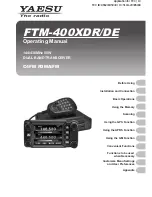
93
1. Introduction
Recommendations
The user must not attempt to access the
siren’s internal parts, except areas described
in this manual. If the user does access these
parts, the product guarantee will be
considered null and void and DAITEM shall
not be held responsible for any problems.
Touching the siren’s internal parts and/or
electronic components can damage the
product. Furthermore, the siren is designed
in such a way that these parts and
components do not need to be accessed
for operation or maintenance purposes.
IMPORTANT
• Some functions are only available with versions 2.0.0 or later
(press
on the control panel keypad to check the version).
• The operating differences with former ranges are described in the compatibility booklet
available in the Daitem installers section at www.daitem.co.uk.
The universal transmitter is fitted with:
• a built-in magnetic contact (reed switch
type), for detecting open doors and
windows.
• a terminal block n° 1, for connecting NC
or NO type external contacts,
• a terminal block n° 2, for connecting NC
or NO type external contacts,
• a test button and two-colour test LED
indicator lamp on the front face.
The universal transmitter allows entirely
independent management of 2 detection
loops. Each loop can be used for both
detector type applications and system
control type applications.
(external contacts)
(external contacts)
Loop n° 2
Loop n° 1
(built-in
reed switch
contact)
Test
button
Two-colour
test LED
indicator
lamp
Loop n° 1
IMPORTANT: in test mode, the red LED indicator lamp is associated with loop n° 1
and the green LED indicator lamp with loop n° 2.
2 independent
loops
Detector type application
System control type
application
Loop n° 1
using built-in reed switch type contact
or
using terminal block n° 1
using terminal block n° 1
Loop n° 2
using terminal block n° 2
using terminal block n° 2
1. Introduction..................................................... 93
2. Preparation...................................................... 95
3. Default configuration ..................................... 96
4. Programming .................................................. 97
5. Advanced configuration operations ............ 99
6. Connection.................................................... 103
7. Installation..................................................... 104
8. Operating test............................................... 107
9. Maintenance ................................................. 109
10. Technical data............................................. 110
Contents
Summary of Contents for 221-21 Series
Page 111: ...111 ...
















































